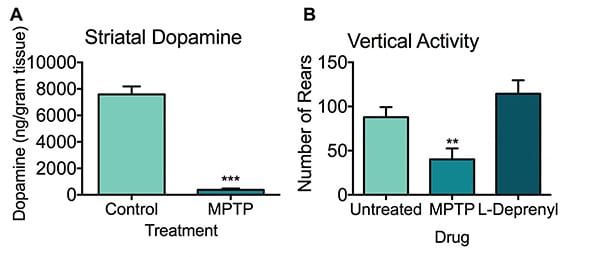MPTP-Induced Mouse Model
Discover how Melior’s unique phenotypic screening platforms can uncover the untapped value of your candidate therapeutic
MPTP is a potent and selective nigrostriatal dopaminergic neurotoxin that in mice, produces many of the neuropathological features of idiopathic Parkinson’s disease in humans. MPTP produces nigrostriatal dopaminergic degeneration and locomotor impairment.
Pharmacological agents that increase dopaminergic function or that block the neurotoxicity of MPTP also attenuate MPTP-associated locomotor and dopaminergic dysfunction. Moreover, MPTP-mediated toxicity may have some relationship to the mechanisms associated with dopaminergic loss in the disease indicating that this model may also be potentially useful for identifying agents that slow or reduce nigrostriatal dopaminergic loss.
There are a number of parameters that Melior normally uses to assess therapeutic potential in the MPTP Parkinson’s disease model;
- Behavioral endpoints are typically Open Field Activity where vertical activity is the parameter most affected by MPTP lesions (vertical activity reduced compared to no lesion).
- Biochemical measurements include quantitation of dopamine and dopamine metabolite levels (Dopamine, DOPAC and HVA) in the striatum.
- Histological endpoints include quantitation of tyrosine hydroxylase (TH) staining in the striatum as an estimation of the number of dopaminergic terminals (striatum) and cell bodies (substantia nigra pars compacta) are present in the treated animals. Stereology cell count of TH-positive neurons in SNpc can be performed.
The study described below illustrates a biochemical validation measures (striatal dopamine and it’s metabolite, DOPAC) in a sample MPTP Parkinson’s disease model study.
Ready to get started or looking for a custom model?
Contact us today for more information about our bespoke research models and to discuss how we can help you answer your unique research questions.
After four days of treatment, mice treated with vehicle/MPTP exhibit significantly reduced levels of dopamine in the striatum (A). Rearing activity, as evaluated in an Open Field Activity test, was reduced in MPTP mice (B). L-Deprenyl, a selective irreversible MAO-B inhibitor, blocks the effect of MPTP treatment and prevented loss-of-rearing. Data are mean ± SEM; **p<.01; ***p<0.001 compared to untreated (control) animals.
The MPTP Parkinson’s disease model is performed in mice. Typical study durations are 4-14 days. Group sizes are customarily 8-12 animals.




